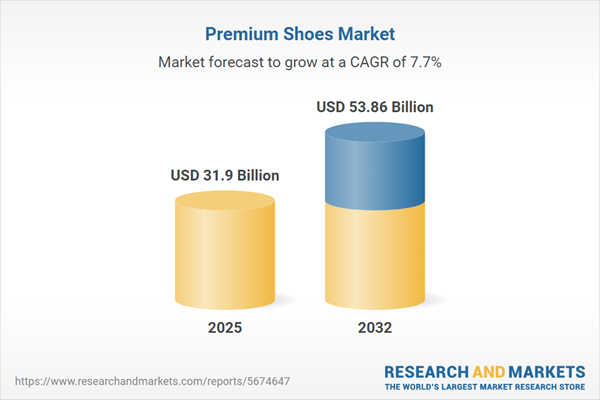Speak directly to the analyst to clarify any post sales queries you may have.
The premium shoes market is evolving fast, with decision-makers adapting to heightened consumer expectations, digital transformation, and an increasingly competitive environment. To drive sustainable growth in this sector, leaders must embrace operational resilience and agile market strategies.
Market Snapshot: Premium Shoes Market Growth & Dynamics
The premium shoes market demonstrates strong ongoing expansion, buoyed by rising demand for expert craftsmanship and engaging brand experiences. Market value stands at USD 29.72 billion in 2024 and is projected to reach USD 31.90 billion in 2025, reflecting a compound annual growth rate (CAGR) of 7.71%. Long-term projections point to continued growth with an outlook toward USD 53.86 billion by 2032.
Industry leaders are adopting digital tools to align their business models with evolving buying journeys. Strategic focus areas include boosting operational productivity, broadening product portfolios, and building the agility to anticipate industry shifts. This approach is setting new leadership standards across the premium segment.Scope & Segmentation: Strategic Premium Shoes Market Analysis
This report offers senior decision-makers targeted insights into the core drivers and structure of the premium shoes market, supporting critical strategic planning. The analysis equips leaders to respond to dynamic consumer trends and competitive threats by detailing the following dimensions:
- Product Types: Includes high-performance athletic shoes, adaptable casual options such as loafers and sneakers, as well as formal footwear. Coverage helps brands serve various lifestyle needs and expand market presence.
- Material Categories: Assesses market share for premium leathers, advanced synthetics, technical foams, robust rubbers, and eco-oriented textiles. Such materials advance both durability and sustainability goals, strengthening brand differentiation.
- End Users: Encompasses adult and children's footwear segments, examining comfort, longevity, and design factors that drive loyalty across all age groups.
- Distribution Channels: Considers a spectrum of channels, including direct-to-consumer ecommerce, classic department stores, branded outlets, proprietary digital platforms, and partnerships with specialized distributors, optimizing market access and engagement.
- Geographic Regions: Reviews markets throughout the Americas, Europe, Middle East, Africa, and Asia-Pacific, with in-depth analysis of regional priorities in China, India, Japan, Australia, and Southeast Asia to inform tailored go-to-market plans.
- Leading Companies: Provides strategy insights and positioning for top brands such as Nike, Adidas, VF Corporation, PUMA, Under Armour, ASICS, Deckers, Lululemon, Kering, Caleres, Brooks Sports (Berkshire Hathaway), Lotto Sport Italia, Mason Garments, New Balance, Newton Running, On Holding, Salvatore Ferragamo, Saucony (Wolverine World Wide), SOREL Corporation, Steven Madden, and The Rockport Company (ABG Rockport).
Key Takeaways: Strategic Insights for Senior Executives
- Advance digital transformation to streamline operations, improve customer experience, and enable future-ready growth using innovative technology.
- Build an authentic brand identity by delivering distinct narratives, strengthening customer loyalty and competitive positioning in the premium market.
- Integrate sustainable sourcing and production methods to satisfy stakeholder demands and enhance long-term organizational value.
- Apply technologies like augmented reality to connect physical and online shopping experiences, raising the standard for customer engagement.
- Implement unified multi-channel marketing to reach diverse consumer bases, tailoring communication for both digital and traditional shoppers.
- Foster supply chain resilience by diversifying sourcing and mitigating disruption, ensuring stability across volatile industry conditions.
Tariff Impact: Navigating Supply Chain and Material Disruption
Shifting U.S. tariffs are prompting premium shoe manufacturers to reevaluate their supply chains for greater flexibility and compliance. Executive teams are broadening supplier networks, increasing investment in regional production, and incorporating advanced biotechnology-based materials. These actions support cost control and ensure operational fluidity amid dynamic regulatory changes.
Methodology & Data Sources: Premium Shoes Market Research
This research combines senior executive interviews, broad industry surveys, and regulatory reviews with advanced analytics and geospatial modeling. The methodology ensures all qualitative data is translated into actionable insights for organizational leaders, giving a comprehensive view of the premium shoes market.
Why This Report Matters: Senior Executive Value Proposition
- Empowers senior leaders with strategic guidance on digital innovation and risk mitigation in premium footwear.
- Facilitates confident expansion and informed portfolio decisions, even in complex or evolving environments.
- Delivers actionable, data-driven insights for robust risk management and targeted product planning.
Conclusion: Executing Strategic Market Leadership
Operational innovation and digital prioritization are essential for sustainable market growth. Senior executives succeeding in the premium shoes industry demonstrate agility and resilience, positioning their organizations for long-term success.
Additional Product Information:
- Purchase of this report includes 1 year online access with quarterly updates.
- This report can be updated on request. Please contact our Customer Experience team using the Ask a Question widget on our website.
Table of Contents
3. Executive Summary
4. Market Overview
7. Cumulative Impact of Artificial Intelligence 2025
Companies Mentioned
The companies profiled in this Premium Shoes market report include:- Nike, Inc.
- Adidas AG
- VF Corporation
- PUMA SE
- Deckers Outdoor Corporation
- Under Armour, Inc.
- ASICS Corporation
- Lululemon Athletica Inc.
- Brooks Sports Inc. by Berkshire Hathaway Inc.
- Caleres Inc.
- Kering SA
- Lotto Sport Italia Spa
- Mason Garments B.V.
- New Balance Athletics Inc.
- Newton Running Co. Inc.
- On Holding AG
- Salvatore Ferragamo S.p.A.
- Saucony by Wolverine World Wide, Inc.
- SOREL Corporation
- Steven Madden Ltd.
- The Rockport Company LLC by ABG Rockport LLC
Table Information
| Report Attribute | Details |
|---|---|
| No. of Pages | 188 |
| Published | October 2025 |
| Forecast Period | 2025 - 2032 |
| Estimated Market Value ( USD | $ 31.9 Billion |
| Forecasted Market Value ( USD | $ 53.86 Billion |
| Compound Annual Growth Rate | 7.7% |
| Regions Covered | Global |
| No. of Companies Mentioned | 22 |









